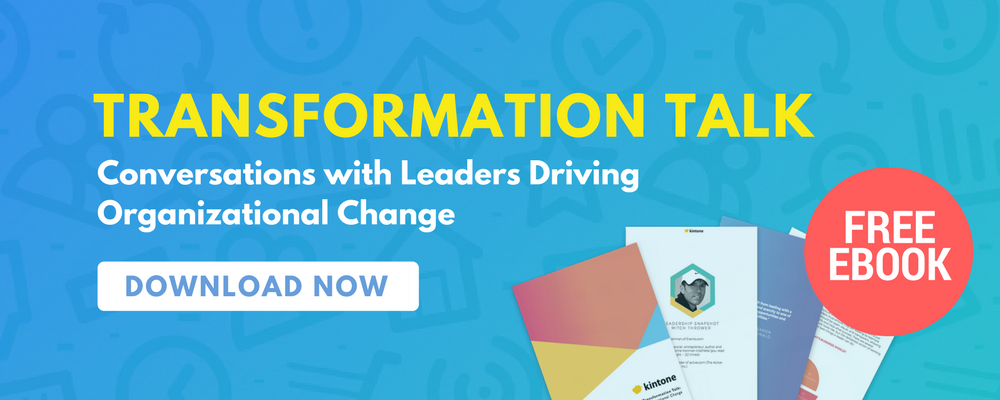These are among the burning questions we wanted to ask people who have led impactful change initiatives at organizations of all shapes and sizes.
By tapping into their wisdom, we'll share some real examples of change projects through the eyes of the leaders behind them. Our goal is to generate a conversation about the struggles, successes and skills needed to lead meaningful change at your own organization.
We're calling this Transformation Talk and our first guest Amir Ghannad couldn't be a better fit to launch the series.
Amir, the Senior Director of Global People Excellence at Campbell Soup Co., is the author of a new book "The Transformative Leader." In it, he takes readers on a personal journey of self-discovery and provides an abundance of insight into the beliefs, skills, actions, and habits of exceptional change leaders.
Amir began his corporate career at Procter and Gamble over 30 years ago and had been deployed to quite a few turnaround situations, but he wouldn't face his greatest challenge until a little over a decade ago when he accepted a position as the plant manager of a plant that had recently been divested from P&G and was the worst performing plant in the company.
"All of our results were terrible, morale was even worse," he said. Up until that point in his career, he said he felt he had accomplished a lot and progressed in his career, but had hit a wall.
Change leadership begins with self-reflection

Amir and his team started solving some of the problems, but he realized they were only going through the motions, and creating more problems in the end.
Going through the most challenging situation of his career up to that point, Amir painfully realized that rather than focusing on all of the external, highly visible problems right in front of him, he needed to bring his attention inward.
"If I really wanted to make progress, I needed to look to myself to figure out first what was holding me back from providing the right kind of leadership," he said
Within a year and a half, he and his team managed to turn the plant around to being the best performing plant in the company and delivering industry benchmark results.
"It really came down to winning the hearts and minds of people in the plant," he said. His team, which had been in a low-trust environment for a long time, was looking for evidence that he actually cared about their success, in and outside of work.
FREE DOWNLOAD: Transformation Blueprint To Facilitate Change In Your Life & Company
It didn't start off as some heavily documented strategic plan either. "I just really did what I felt needed to be done from the heart," he said. "It took a lot of steps to demonstrate to the employees that I was genuinely interested in them succeeding and what emerged was a more productive team."
He first examined some of the systematic issues that were getting in the way, such as people having to go to their boss to get approval for every little thing. So he gave them autonomy and the freedom to do whatever they needed to do their jobs better.
This was the foundation for his two-part vision to start investing in employees: 1. Be the showcase of excellence. 2. Create a cradle of prosperity.
The latter has to with showing genuine interest in employees living an extraordinary life. Interventions were made on the business front to give people room to make their own decisions, while addressing struggles outside of work at the same time.
Among those struggles were financial issues. To tackle it straight on, Amir and his wife started teaching 13-week Dave Ramsey financial classes at the plant for employees and their families.
Amir expanded efforts to include lunch and learn series on health issues, and even marriage and relationship counseling.
"I was really trying to take care of the people who took care of the business," he said.
After the plant turnaround, Amir was asked to take his approach to the other company plants. For the next three years, he led the workplace excellence effort and even created a three-month course that was held at all the sites, including the company headquarters, with very favorable results.
His training focused on leaders looking inward to develop the necessary mindset and characteristics to create a High Commitment Culture.
"Leaders really need to pay attention to their own authenticity," Amir said. "Do I have integrity? Am I committed to something bigger than myself? Because as a leader if I'm simply committed to my own success, I'm not a big enough reason to hang in there when the going gets tough."
When he works with leaders, the first thing he asks is "are you trying to solve a problem, or are you going for a breakthrough?" Once people are clear on their motives, he'll then take them through the process to understand what their internal barriers are to accomplishing those goals.
 "Most of us drag a lot of things with us from the past that turn into limiting thoughts, and we don't act on certain aspirations that we have because of something that happened 10, 20, or 30 years ago," he said. "I work with leaders to compel them to put their baggage down."
"Most of us drag a lot of things with us from the past that turn into limiting thoughts, and we don't act on certain aspirations that we have because of something that happened 10, 20, or 30 years ago," he said. "I work with leaders to compel them to put their baggage down."
This is just one of the steps in what he calls the three C's of success: Complete the past, Choose the present as if you had a choice, and Create the future and live into it.
Behave your way into thinking
Whether you’re a seasoned change leader, or someone starting their journey, Amir recommends always having a coach. It doesn’t have to be someone that you hire. It could be someone you have a relationship with, such as a mentor or even a peer.
"It should be someone who can be objective and help you manage the dialogue in your head," Amir said. "Someone who can help you behave your way into a new way of thinking instead of trying to think your way into a new way of behaving."
An example he uses to illustrate this is that when his alarm goes off in the morning when he is supposed to get up and exercise, he has the option to get engaged in that dialogue and debate in his head about whether he should get up or not or he can actually get up and put on his exercise clothes and get started with his routine while that dialogue is going on.
ALSO READ: Jill Dyché, Author of 'New IT,' Talks Cultivating Change, IT Education & Good Wine
The former approach always leads to several snoozes and no exercise but the latter leads to him eventually feeling good that he got up and went through with his plan.
"Sometimes it's just about getting on the court and not giving into dialogue in your head," he said. "A coach can help."
It's the size of your commitment, not your challenges
 As far as organizations go, he said the greatest barrier to change is when we focus more on our challenges rather than commitment. "It's always the size of your commitment that gets you stuck," he said. "Not the size of your challenges."
As far as organizations go, he said the greatest barrier to change is when we focus more on our challenges rather than commitment. "It's always the size of your commitment that gets you stuck," he said. "Not the size of your challenges."
He uses the example of athletes in the Paralympics. While many of them are missing limbs or abilities that the rest of us take for granted, they are performing much better than people who have all their functioning limbs. Their commitment to succeed overrides their extreme challenges.
In this vein, Amir said there are two questions that will inform your experience of leadership: 1. What outcome am I truly committed to creating? 2. What is the most important step I can take now?
"Don't settle for change when you can lead a transformation"
Amir says while traditional change management tools are good and necessary, it's more effective when you really get in touch with the transformation you are out to create instead of just checking off your to-do-list.
In his blog, Amir writes that he’s witnessed firsthand large corporations trying to replicate great things happening in smaller parts of the organization “only to find out that when the steps were taken and boxes were checked, the magic was missing.”
“I’m concerned that the supply and demand for cookie-cutter culture change formulas and silver bullets will continue to elude us and keep us from exploring what it takes to truly bring about permanent shifts in our workplace cultures and results,” he writes.
So how can we scale culture transformation without losing that magic?
"By recognizing that the magic lies in the small, seemingly inconsequential moments along the journey,” Amir said.
For authentic change to happen, each team member needs to be able to freely choose and commit to the idea of beginning the transformation process with himself/herself.
“Assuming you subscribe to this idea,” Amir said, “the challenge becomes one of discerning how to create that moment of truth for a critical mass of the people in the organization and gain unstoppable momentum.
Amir says that in smaller organizations with limited resources for “fancy tools,” this usually happens organically through conversations before supporting change efforts with larger, more visible interventions.
It’s typically a different situation in larger organizations where there is a desire to be efficient with culture transformation. “The big speeches, announcements, posters, logo, surveys, and systems to measure progress tend to be perceived as the main thing and we tend to forget that the magic happens one conversation at a time, and the personal choice to be committed arises out of each individual’s experience of their workplace, or their boss, or their work,” Amir said.
Larger and smaller organizations have different needs and therefore will need to deploy different strategies to generate the right conversations. Amir said using sophisticated tools as a means to generate the right conversations is important, so long as it’s done intentionally and isn’t seen as a shortcut to cultivate commitment.
And as Amir and history reminds us, some of the greatest change leaders were inspired by spontaneous action, not some measurable strategic plan. Rosa Parks refusal is a great example of an unscripted approach with significant ripple effects. “Likewise, the game changers in organizational culture transformation can happen in every interface, every conversation, and every decision,” Amir said.
For reflection
- What kind of culture are you committed to creating at your workplace?
- Do you rely on programs and processes to bring about a culture shift, or have you declared yourself 100% committed and accountable?
- What opportunities do you have to clearly demonstrate your commitment?
You can also visit Amir's blog for his weekly posts.
About the Author
Nicole is Director of Marketing at Kintone, with 10+ years experience in content strategy, campaign management, lead acquisition and building positive work cultures of empowered, purpose-driven team members. She spent seven years as a journalist, previously serving as a CBS San Francisco digital producer, NPR contributor, Patagon Journal deputy editor and reporter for several publications, including the Chicago Tribune. She's passionate about the tech for good space, social entrepreneurship and women leadership. On the weekends, you’ll likely find her putting her Master Gardener skills to use in at community gardens in Oakland.











